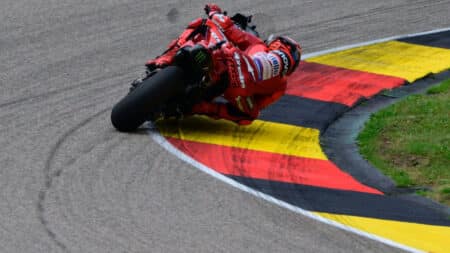At the same time you’re storing thousands of tiny details in your memory banks – what you did during the last lap, how the motorcycle reacted, why you think it reacted like that, how you could do it better next time and how you’d like the motorcycle to react better next time.
The theory that Márquez doesn’t know how to set up and develop a bike is something you’ll only hear from people outside the paddock.
“In all the years I’ve worked in racing I’ve not known any rider at his level of knowledge of the bike and knowledge about set-up,” says one of his crew chiefs.
“Marc is so clever,” adds one of his team bosses. “He has a wider way to see and to follow the goal. He knows that everything around him makes performance. That’s why he is really deeply concentrated on whoever and whatever is around him. The engineers, the mechanics, his manager, his girlfriend, they all make performance.”
“Marc isn’t just riding talent,” says another multiple MotoGP champ. “He’s pretty much smarter than a lot of them as well. When you get down to the nitty-gritty he’s a very, very intelligent cat. That’s why he’s so good at battling people and it’s why he’s so calm in most situations.”

Márquez during his glory years at Honda – six titles in seven years
HRC
This is a former rival talking, “The reason Marc is what he is, is his racecraft, how he manages races and how he races, not only how he rides. It’s how tactical he is.”
Who remembers Brno 2017? The race started on a wet track, everyone playing safe with rain tyres. During the second lap Marc slipped from second, behind Jorge Lorenzo, to tenth. What was going on?
He was keeping his strategy secret. He knew his rivals would follow him into the pits if he came in for slicks when he was up the front, so he let them by one by one – Rossi, Andrea Dovizioso, Maverick Viñales, Johann Zarco, Dani Pedrosa, Danilo Petrucci, Cal Crutchlow and Aleix Espargaró – then dived into pitlane.
When he returned to the track aboard his slick-equipped Honda RC213V he was 17th. Five laps later he had a 19-second lead.
“I could just see him [heading for pitlane] as we went into the last corner at the end of the second lap,” laughed one of his rivals. “I thought, ‘You bastard!’ because I knew he had out-foxed us again, the same as at the Sachsenring the previous year.”
Third, bravery. There’s no one braver than Márquez, because even now no-one has adopted his way of finding the limit, by going past it and (sometimes) crashing. Why does he do this? Because it saves time during practice, allowing his engineers to make more progress with set-up. No pain, no gain.
“Marc goes over the limit and then he understands where’s the limit,” says one of his engineers. “Other riders build towards the limit: one step, another step, one more step… and maybe they finally get there. But it takes longer.”
Fourth, determination. This includes the willingness to suffer and sacrifice, through total dedication to the cause and through injury, because you won’t get anywhere in motorcycle racing unless you’re prepared to smash yourself to pieces and come back for more, time and time again.
Márquez’s comeback is unique. No other rider has gone six seasons between winning the title, suffering a serious injury, and winning the title again. Another piece of history.

Márquez celebrating his last championship victory – his eighth world title and sixth MotoGP crown – way back in October 2019
HRC
“I’m not sure any another sportsman or sportswoman has been able to come back from an injury like he’s had,” says Doohan, who went two years between breaking a leg and then winning his first MotoGP title. “For me, he’s just a different breed.”
And if Mighty Mick says that…
Carl Fogarty broke his left humerus in 2000, underwent the same corrective surgery as Márquez – a titanium plate and screws – then tried to return to racing five months later.
“I couldn’t find the words to describe how bad it was when I came in after a few laps,” said Foggy after an exploratory outing at Mugello. “I was 1% of the guy I was a few months ago. I couldn’t even get down behind the bubble, change direction or hang off the bike. It confirmed everything that my specialist had said – the arm would no longer be able to take the constant pounding.”








